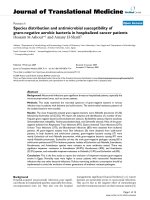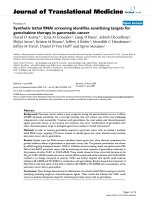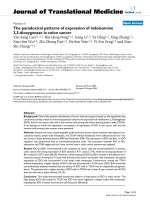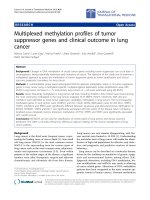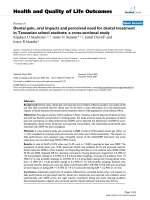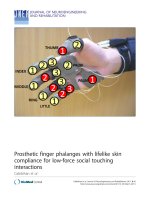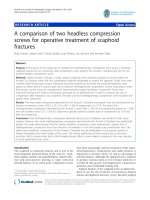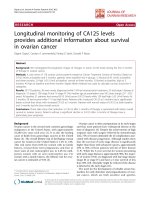báo cáo hóa học:" Synthetic lethal RNAi screening identifies sensitizing targets for gemcitabine therapy in pancreatic cancer" doc
Bạn đang xem bản rút gọn của tài liệu. Xem và tải ngay bản đầy đủ của tài liệu tại đây (1.6 MB, 12 trang )
BioMed Central
Page 1 of 12
(page number not for citation purposes)
Journal of Translational Medicine
Open Access
Research
Synthetic lethal RNAi screening identifies sensitizing targets for
gemcitabine therapy in pancreatic cancer
David O Azorsa*
1
, Irma M Gonzales
1
, Gargi D Basu
1
, Ashish Choudhary
1
,
Shilpi Arora
1
, Kristen M Bisanz
1
, Jeffrey A Kiefer
1
, Meredith C Henderson
1
,
Jeffrey M Trent
2
, Daniel D Von Hoff
3
and Spyro Mousses
1
Address:
1
Pharmaceutical Genomics Division, The Translational Genomics Research Institute, Scottsdale, Arizona 85259, USA,
2
Genetic Basis of
Human Disease Division, The Translational Genomics Research Institute, Phoenix, Arizona 85004, USA and
3
Clinical Translational Research
Division, The Translational Genomics Research Institute, Phoenix, Arizona 85004, USA
Email: David O Azorsa* - ; Irma M Gonzales - ; Gargi D Basu - ;
Ashish Choudhary - ; Shilpi Arora - ; Kristen M Bisanz - ;
Jeffrey A Kiefer - ; Meredith C Henderson - ; Jeffrey M Trent - ; Daniel D Von
Hoff - ; Spyro Mousses -
* Corresponding author
Abstract
Background: Pancreatic cancer retains a poor prognosis among the gastrointestinal cancers. It affects
230,000 individuals worldwide, has a very high mortality rate, and remains one of the most challenging
malignancies to treat successfully. Treatment with gemcitabine, the most widely used chemotherapeutic
against pancreatic cancer, is not curative and resistance may occur. Combinations of gemcitabine with
other chemotherapeutic drugs or biological agents have resulted in limited improvement.
Methods: In order to improve gemcitabine response in pancreatic cancer cells, we utilized a synthetic
lethal RNAi screen targeting 572 known kinases to identify genes that when silenced would sensitize
pancreatic cancer cells to gemcitabine.
Results: Results from the RNAi screens identified several genes that, when silenced, potentiated the
growth inhibitory effects of gemcitabine in pancreatic cancer cells. The greatest potentiation was shown
by siRNA targeting checkpoint kinase 1 (CHK1). Validation of the screening results was performed in MIA
PaCa-2 and BxPC3 pancreatic cancer cells by examining the dose response of gemcitabine treatment in
the presence of either CHK1 or CHK2 siRNA. These results showed a three to ten-fold decrease in the
EC
50
for CHK1 siRNA-treated cells versus control siRNA-treated cells while treatment with CHK2 siRNA
resulted in no change compared to controls. CHK1 was further targeted with specific small molecule
inhibitors SB 218078 and PD 407824 in combination with gemcitabine. Results showed that treatment of
MIA PaCa-2 cells with either of the CHK1 inhibitors SB 218078 or PD 407824 led to sensitization of the
pancreatic cancer cells to gemcitabine.
Conclusion: These findings demonstrate the effectiveness of synthetic lethal RNAi screening as a tool for
identifying sensitizing targets to chemotherapeutic agents. These results also indicate that CHK1 could
serve as a putative therapeutic target for sensitizing pancreatic cancer cells to gemcitabine.
Published: 11 June 2009
Journal of Translational Medicine 2009, 7:43 doi:10.1186/1479-5876-7-43
Received: 12 March 2009
Accepted: 11 June 2009
This article is available from: />© 2009 Azorsa et al; licensee BioMed Central Ltd.
This is an Open Access article distributed under the terms of the Creative Commons Attribution License ( />),
which permits unrestricted use, distribution, and reproduction in any medium, provided the original work is properly cited.
Journal of Translational Medicine 2009, 7:43 />Page 2 of 12
(page number not for citation purposes)
Background
Pancreatic cancer is one of the most aggressive and lethal
cancers known today, with a 5-year survival of only 4%. In
2008, pancreatic cancer was the fourth-leading cause of
cancer-related deaths [1]. Patients diagnosed with pancre-
atic cancer typically have poor prognosis partly because
the cancer usually causes no symptoms early on, leading
to metastatic disease at the time of diagnosis. The treat-
ment options include chemotherapy, surgery and radia-
tion. The current preferred therapeutic drug to treat
pancreatic cancer is gemcitabine, yet the one-year survival
of pancreatic cancer patients treated with gemcitabine is
only about 18%, representing a significant but modest
advancement in the quality of life [2,3].
Gemcitabine (2', 2'-difluoro 2'-deoxycytidine) is a pyrimi-
dine based nucleoside analogue that replaces the nucleic
acid cytidine during DNA replication thereby arresting
tumor growth since new nucleosides cannot be attached
to the faulty nucleoside resulting in apoptosis [4]. Besides
pancreatic cancer, gemcitabine is also used for the treat-
ment of various other carcinomas including non-small
cell lung cancer [5], ovarian cancer [6] and breast cancer
[7]. Due to the poor prognosis of pancreatic cancer,
improved therapies are desperately needed and it would
be of great benefit to identify agents that sensitize to gem-
citabine. Adding other chemotherapeutic agents to gem-
citabine has not resulted in meaningful improvement in
survival of pancreatic cancer patients. Randomized trials
studying the addition of molecular targeting agents
(cetuximab, bevacizumab, farnesyl transferase inhibitors
and metalloproteinase inhibitors) to gemcitabine com-
pared with gemcitabine alone have been disappointing
(for review see [8]). Therefore, newer strategies need to be
devised to improve current chemotherapeutic treatments.
In order to identify potential sensitizers to gemcitabine,
we employed a functional genomics approach based on
high-throughput RNA interference (HT-RNAi) also
known as loss-of-function screening. HT-RNAi when
combined with drug treatment becomes a platform for
identifying synthetic lethality. The basis of this technology
is RNA interference (RNAi), a robust method of post-tran-
scriptional silencing of genes using double-stranded RNA
(dsRNA) in the form of either siRNA (short interfering
RNA) or shRNA (short hairpin RNA) with sequence
homology driven specificity [9]. Large-scale libraries of
siRNA and shRNA have been used to identify genes
involved in many biological functions [10-17]. As kinases
are becoming important drug targets for the treatment of
cancer, the identification of kinases that act as sensitizing
targets to gemcitabine will facilitate the design and devel-
opment of better drug combinations for treatment of pan-
creatic cancer.
In this study, our goal was to develop and implement a
robust synthetic lethal assay in order to identify genes that
potentiate the response to gemcitabine in pancreatic can-
cer cells. Using a kinase siRNA library, we identified sev-
eral candidate genes and functionally validated one gene,
CHK1, as a sensitizing target using gene specific siRNA in
combination with gemcitabine treatment. Furthermore,
specific inhibitors of CHK1 were confirmed to have syner-
gistic response with gemcitabine treatment in pancreatic
cancer cells.
Materials and methods
Cell culture
The human pancreatic cancer cell lines MIA PaCa-2 and
BxPC3 were obtained from the American Type Culture
Collection (Manassas, VA). The MIA PaCa-2 cell line was
established by Yunis, et al. in 1975 from tumor tissue of
the pancreas obtained from a 65-year-old Caucasian male
[18]. The established cell line reportedly has a doubling
time of about 40 hours and a colony-forming efficiency in
soft agar of approximately 19%. BxPC3 cells were derived
from a 61-year-old female with a primary adenocarci-
noma of the pancreas. BxPC-3 cells produce mucin and
form tumors, which are moderately to poorly differenti-
ated, in nude mice similar to the primary adenocarci-
noma. Cells were grown in Dulbecco's modified Eagle
medium (DMEM) or RPMI-1640 respectively, supple-
mented with 10% FBS, 2 mM L-glutamine, 100 IU/ml
penicillin G, and 100 μg/ml streptomycin and B. All
media reagents were obtained from Invitrogen (Carlsbad,
California, USA). The cell lines were routinely maintained
at 37°C in a humidified 5% CO
2
atmosphere.
Reagents
Gemcitabine chlorohydrate (Eli Lilly; Indianapolis, Indi-
ana, USA) was obtained from the Mayo Clinic Pharmacy
(Scottsdale, Arizona, USA) and stock solutions of 100 mM
were prepared by dissolving gemcitabine in serum free
DMEM. Aliquots of gemcitabine were stored at -20°C
until use. The CHK1 inhibitors PD 407824 and SB
218078 were obtained from Tocris (Ellisville, Missouri,
USA) and EMD Biosciences (Madison, Wisconsin, USA),
respectively and 10 mM stock solutions were prepared in
DMSO. Short interfering RNAi targeting CHK1 or CHK2
and a non-silencing control were obtained from Qiagen
(Valencia, California, USA). The siRNA target sequences
were as follows: CHK1-A, AAGAAAGAGATCTGTATCAAT;
CHK1-B, TTGGAATAACTCCACGGGATA; CHK1-C,
AACTGAAGAAGCAGTCGCAAGT; CHK1-D, CCCG-
Journal of Translational Medicine 2009, 7:43 />Page 3 of 12
(page number not for citation purposes)
CACAGGTCTTTCCTTAT; CHK2-A, ACGCCGTCCTTT-
GAATAACAA; CHK2-B, AGGACTGTCTTATAAAGATTA;
CHK2-C, CAGGATGGATTTGCCAATCTT; and CHK2-D,
CTCCGTGGTTTGAACACGAAA. The sequences used in
HT-RNAi screening were the A and B sequences for both
CHK1 and CHK2.
Synthetic lethal RNAi screening
High-Throughput RNAi (HT-RNAi) was performed using
the validated kinase siRNA library version 1.0 obtained
from Qiagen. This library includes siRNA to 572 kinases
with 2 siRNA per gene that have all been validated by
quantitative real time PCR (qRT-PCR) to silence mRNA
up to 75%. Stock siRNA was diluted in siRNA buffer (Qia-
gen) and 9.3 ng of siRNA was printed onto white Corning
384-well plates (Fisher Scientific; Pittsburgh, PA). HT-
RNAi was done by reverse transfection of cells. Briefly,
diluted siLentFect reagent (BioRad, Hercules, CA) in Opti-
MEM (Invitrogen) was added to the wells and allowed to
complex with siRNA for 30 min at room temperature.
MIA PaCa-2 cells were resuspended in growth media with-
out antibiotics at a final concentration of 1000 cells/well.
Plates were incubated at 37°C with 5% CO
2
. After 24
hours, either vehicle (serum free media) or gemcitabine
was added to the wells and plates were further incubated
for 72 hours. The final siRNA concentration is 13 nM.
Total cell number was determined by the addition of Cell
Titer Glo (Promega, Madison, Wisconsin, USA) and rela-
tive luminescence units (RLU) were measured using an
EnVision plate reader (Perkin-Elmer, Wellesley, Massa-
chusetts, USA). Raw RLU data was used to calculate viabil-
ity relative to the control wells. Log
2
ratios of viability
from siRNA and gemcitabine treated wells versus siRNA
and vehicle treated wells were computed. Hits were iden-
tified as having log
2
ratios that are 1.65 standard devia-
tions (SD) below the mean ratio level. This cutoff was
chosen due to the relatively small size and focused nature
of the screen.
Validation of gene silencing
To demonstrate the silencing efficiency of the siRNA tar-
geting CHK1 or CHK2, MIA PaCa-2 were transfected with
16 nM of siRNA targeting CHK1 or CHK2 or non-silenc-
ing siRNA in 6-well plates by reverse transfection as
described above. The experiment was run in duplicate and
cells were incubated at 37°C for 48 hours prior to RNA
extraction or 72 hours prior to preparation of protein
lysates for Western Blotting.
Quantitative real time PCR
RNA extraction was done using Qiagen RNAeasy kit (Qia-
gen) and cDNA was prepared using iScript cDNA synthe-
sis kit (BioRad Laboratories, CA) [19]. Quantitative real-
time PCR using TaqMan assays (Applied Biosystems) was
performed to verify gene silencing of CHK1/CHK2
(Hs00967502_m1 and Hs01007290_m1, respectively).
The relative quantification was done using the Ct values,
determined for triplicate reactions for test and reference
samples for each target and for the internal control gene
[GAPDH; (Hs99999905_m1)]. Relative expression levels
were calculated as 2
-ΔΔCt
, where ΔΔCt = ΔCt (target sam-
ple) - ΔCt (reference sample) [19].
Western blot analysis
Cells were treated with siRNA for 72 hours and cell lysates
were prepared as described previously [20]. Protein con-
centration was determined by BCA assay (Pierce; Rock-
ford, Illinois, USA) and lysates were resolved by SDS-
PAGE on 4–12% resolving gel. Proteins were transferred
onto PVDF (polyvinylidene fluoride) membranes (Invit-
rogen) and CHK1 protein was identified using a mouse-
anti-CHK1 monoclonal antibody (Santa Cruz Biotechnol-
ogy; Santa Cruz, California, USA) and an HRP-conjugated
goat anti-mouse secondary antibody (Jackson Immu-
noResearch Laboratories, Inc; West Grove, Pennsylvania,
USA). Bound antibodies were detected using SuperSignal
West Femto (Pierce) and imaged using an AlphaInnotech
Imager.
Functional validation for gemcitabine sensitization
For siRNA and gemcitabine studies, cells were transfected
with siRNA plated in 384-well plates similar to screening
conditions. Twenty-four hours later, the cells were treated
with varying doses of gemcitabine in quadruplicate wells
for each siRNA plus gemcitabine condition. Cell viability
was determined 72 hours after drug addition using Cell
Titer Glo. For CHK1 inhibitor studies, cells were treated
with either SB 218078 or PD 407824 in 384-well plates
for twenty-four hours prior to gemcitabine treatment. Cell
viability was determined 72 hours after gemcitabine addi-
tion using Cell Titer Glo. Viability was calculated by divid-
ing the average of the RLU values for the drug treated wells
by the average of the RLU values for vehicle treated wells.
The IC
50
values were determined using GraphPad Prism
(GraphPad Software, San Diego, California, USA) and val-
ues were shown as calculated IC
50
+/- 95% confidence
interval.
Label-free impedance measurement of cell growth
The principle of impedance measurement for monitoring
cellular proliferation has been previously described by
Solly et al. [21]. Briefly, siRNA was introduced into MIA
PaCa-2 cells by reverse transfection of 4,000 cells/well
using siLentFect in triplicate wells of an ACEA 96× E-Plate
(ACEA Biosciences; San Diego, California, USA). Gemcit-
abine was added at a final concentration of 10 nM at 24
hours after transfection of the cells. The attachment,
spreading and proliferation of cells were continually
monitored every 60 minutes up to 150 hours, and
changes in impedance were acquired with the real time
Journal of Translational Medicine 2009, 7:43 />Page 4 of 12
(page number not for citation purposes)
cell electronic sensing (RT-CES) system (ACEA Bio-
sciences). Cell growth was determined by plotting cell
index measurements versus time.
Results
Synthetic lethal screening for modulators of gemcitabine
response
In order to identify genes that modulate the response of
pancreatic cancer cells to gemcitabine treatment, we per-
formed synthetic lethal screening using high throughput
RNAi. A robust HT-RNAi assay was developed that
allowed for high efficiency siRNA transfection of MIA
PaCa-2 pancreatic cells by cationic lipids in 384-well
plates. Before the actual HT-RNAi screening, a transfection
optimization was performed using a panel of commer-
cially available transfection reagents and siLentfect was
chosen as it showed the optimal transfection efficiency
(Data not shown). We performed a drug dose response
experiment with varying concentrations of gemcitabine
and chose 5 and 10 nM final concentrations, as we
obtained EC
10–30
doses at these treatment concentrations
(see Additional file 1; Supplemental figure 1).
The HT-RNAi screen involved transfecting MIA PaCa-2
pancreatic cancer cells with validated siRNA library target-
ing 572 kinases followed by treatment at 24 hours with
either vehicle or low concentration (5 or 10 nM) gemcit-
abine and with further incubation for an additional 72
hours. Cell viability was assessed using a luminescence-
based cell number assay and the data was analyzed as
described in Materials and Methods. Two independent
HT-RNAi screens were conducted using 5 and 10 nM gem-
HT-RNAi kinase screening for identification of sensitizers to gemcitabineFigure 1
HT-RNAi kinase screening for identification of sensitizers to gemcitabine. HT-RNAi screens were performed on
MIA PaCa-2 cells transfected with a siRNA library targeting 572 kinases followed by treatment with either vehicle or 5 nM or
10 nM gemcitabine. Cell viability was assessed and normalized to control wells. (A) Scatterplot of the log
2
values of cell viability
for gemcitabine plus siRNA treated cells versus vehicle plus siRNA treated cells showed CHK1 as a significant hit. (B) Plot of
log
2
ratios of gemcitabine/vehicle for each siRNA treated with either 5 nM or 10 nM gemcitabine. (C) Empirical Probability
Distribution of log
2
ratios of gemcitabine/vehicle (5 nM and 10 nM). Hit areas are highlighted in red. (D) Venn diagram of gene
hits from both the 5 nM (highlighted in pink) and 10 nM (highlighted in yellow) gemcitabine synthetic lethal RNAi screen.
Journal of Translational Medicine 2009, 7:43 />Page 5 of 12
(page number not for citation purposes)
citabine (Figure 1). The raw cell viability data was normal-
ized to untreated wells within each assay plate. Synthetic
lethal RNAi screening results are shown as a scatterplot of
the log
2
values of normalized cell viability for siRNA plus
gemcitabine treated cells versus siRNA plus vehicle treated
cells (Figure 1A). Results identified CHK1 as a significant
hit. Log
2
viability ratios of individual siRNA for the kinase
siRNA screen were calculated (see Additional file 2).
Further visualization of the screening data included dot
plots of log
2
viability ratios of (siRNA + gemcitabine)/
(siRNA + vehicle) for both the 5 nM and 10 nM concen-
trations (Figure 2B) and Empirical Probability Distribu-
tion of the log
2
ratios for the 5 nM and 10 nM
concentrations (Figure 1C). Both analyses showed that
CHK1 siRNA highly potentiated gemcitabine response.
Significant siRNA hits from both the screens are shown in
the Venn diagram (Figure 1D). The results idenified 25
siRNA that potentiated the effect of 5 nM gemcitabine and
62 siRNA that were potentiators at 10 nM gemcitabine. Of
interest was the finding that 20 siRNA were common on
both lists. These overlapping hits included both siRNA
Validation of gene silencing by CHK1 siRNAFigure 2
Validation of gene silencing by CHK1 siRNA. MIA PaCa-2 cells were transfected with either CHK1 or control siRNA
and allowed to grow for 48–72 hrs. (A) Total RNA from the siRNA treated MIA PaCa-2 cells was isolated at 48 hrs and ana-
lyzed by qRT-PCR for CHK1 expression. CHK1 expression for each siRNA treatment was compared to untreated cells.
GAPDH was used as an internal control for all the samples and fold change was calculated by normalizing all the data to
GAPDH expression. (B) Lysates from CHK1 siRNA treated MIA PaCa-2 cells were prepared at 72 hrs post transfection and
analyzed by western blot for expression of CHK1 protein using an anti-CHK1 antibody. (C) CHK1 siRNA treated cells
showed decreased growth of MIA PaCa-2 cells at 72 hours after siRNA transfection when compared to no siRNA treatment
or non-silencing siRNA treatment. Cell images were taken at 20× magnification.
Journal of Translational Medicine 2009, 7:43 />Page 6 of 12
(page number not for citation purposes)
targeting CHK1 as well as both siRNA targeting ATR. Sev-
eral other interesting candidate genes were also identified
such as CAMK1, STK6, PANK2 and EPHB1, all of which
have been previously reported as being involved in cancer
(Figure 1D) [22-25].
Validation of gene silencing by CHK1 siRNA
To demonstrate the silencing efficiency of the siRNA tar-
geting CHK1 or CHK2, MIA PaCa-2 cells were transfected
with four CHK1 or CHK2 siRNA targeting different
sequences or non-silencing siRNA. The experiment was
run in duplicate and cells were incubated at 37°C for 48
hours prior to RNA extraction or 72 hours prior to the
preparation of protein lysates. Expression analysis using
qRT-PCR clearly showed that CHK1 (Figure 2A) and
CHK2 (see Additional file 1; Supplemental figure 2) genes
were silenced by all the four siRNA used, respectively. For
all the qRT-PCR experiments, GAPDH was used as the
internal control. In addition, cell lysates were analyzed by
western blot using an anti-CHK1 antibody (Figure 2B)
and images of the siRNA treated cells were captured (Fig-
ure 2C). Results show that all four CHK1 siRNA were able
to reduce the CHK1 mRNA and protein levels compared
to non-silencing control siRNA. The Western blots were
also probed with anti-Tubulin antibodies to demonstrate
equal protein loading (Figure 2B). MIA PaCa-2 cells
treated with CHK1 siRNA showed decreased growth com-
pared to non-silencing siRNA treated cells and no siRNA
control (Figure 2C).
Gene silencing of CHK1 potentiates the response to
gemcitabine
In order to validate the synthetic lethal screening result
indicating CHK1 as a sensitizing target for improving
Validation of CHK1 as a sensitizing target to gemcitabine in pancreatic cancer cellsFigure 3
Validation of CHK1 as a sensitizing target to gemcitabine in pancreatic cancer cells. MIA PaCa-2 and BxPC3 pan-
creatic cancer cells were transfected with either CHK1, CHK2 or non-silencing siRNA. After 24 hours, cells were treated with
varying concentrations of gemcitabine and incubated for an additional 72 hours. Cell number was assessed and data was nor-
malized to siRNA plus vehicle control and plotted. Silencing of CHK1 showed potentiation of gemcitabine response in (A) MIA
PaCa-2 and (C) BxPC3 cells as seen by the shift in the dose response curves. Silencing of CHK2 did not affect the response to
gemcitabine in either (B) MIA PaCa-2 cells or (D) BxPC3 cells. Data is representative of three independent experiments.
Journal of Translational Medicine 2009, 7:43 />Page 7 of 12
(page number not for citation purposes)
gemcitabine response, we generated drug dose response
curves of MIA PaCa-2 cells treated with gemcitabine in the
presence of CHK1, CHK2 and non-silencing siRNA (Fig-
ure 3). Interestingly, silencing of CHK1 potentiates the
anti-proliferative effect of gemcitabine as seen by the shift
in the dose response curves. The IC
50
of CHK1 siRNA A
and B plus gemcitabine treatment were 1.05 +/- 0.19 nM
and 1.35 +/- 0.15 nM, respectively compared to an IC
50
value of 15.8 +/- 1.2 nM for non-silencing control siRNA.
Similar effects were seen with the CHK1 C & D sequences
(data not shown). Furthermore, we used CHK2 siRNA A &
B for comparison showing minimal change in IC
50
values
(Figure 3B). Similar effects were seen with the CHK2 C &
D sequences (data not shown). We next validated the sen-
sitization results in another human pancreatic cancer cell
line, BxPC3. Drug response IC
50
values in BxPC3 cells
showed similar decrease from 6.9 +/- 2.4 nM for non-
silencing to 2.8 +/- 0.4 nM and 2.4 +/- 0.6 nM for CHK1-
A and CHK1-B siRNA respectively (Figure 3C). This effect
was notably absent in the CHK2 siRNA-treated cells (Fig-
ure 3B and 3D).
Real-time kinetic analysis of gemcitabine sensitization in
pancreatic cells
We next examined the effect of CHK1 siRNA and gemcit-
abine treatment on pancreatic cancer cells using label-free
impedance growth assays (Figure 4). The impedance anal-
ysis showed that treatment of MIA PaCa-2 cells with non-
silencing siRNA plus 10 nM gemcitabine showed slight
decrease in cell number compared to non-silencing siRNA
plus vehicle treatment (Figure 4A). Treatment of MIA
PaCa-2 cells with CHK1-A siRNA and 10 nM gemcitabine
showed a very potent reduction in cell growth compared
to CHK1-A siRNA plus vehicle treatment (Figure 4B). Sim-
ilar results were seen with other CHK1 siRNA (Data not
shown). These results further demonstrate the potentia-
tion of gemcitabine activity by CHK1 silencing.
CHK1 inhibitors sensitize pancreatic cancer cells to
gemcitabine
To confirm CHK1 as a sensitizing target for gemcitabine,
we treated MIA PaCa-2 pancreatic cancer cells with CHK1
inhibitors SB 218078 and PD 407824 (Figure 5A &5B).
MIA PaCa-2 cells treated with 5 μM SB 218078 followed
by varying concentrations of gemcitabine resulted in a
shift of the dose response curve and decreased the IC
50
val-
ues from 22.5 +/- 2.0 nM for vehicle treatment to 8.8 +/-
0.6 nM for SB 218078 treatment (Figure 5A). Similarly,
MIA PaCa-2 cells treated with 375 nM PD 407824 and
gemcitabine resulted in a shift of the dose response curve
and a decrease of the IC
50
values from 17.5 +/- 1.8 nM for
vehicle treatment to 5.0 +/- 0.4 nM for PD 407824 treat-
ment (Figure 5B).
Discussion
In this study, we utilized a synthetic lethal screen based on
high throughput RNAi to identify functionally relevant
genes that could potentiate the response of pancreatic
Kinetic analysis of CHK1 siRNA induced sensitization of gemcitabine responseFigure 4
Kinetic analysis of CHK1 siRNA induced sensitization of gemcitabine response. MIA PaCa-2 cells were transfected
with either CHK1 siRNA or non-silencing siRNA and at 24 hours post transfection, cells were treated with either vehicle or
10 nM gemcitabine. Growth was assessed by impedance measurements at 1-hour intervals and cell index was plotted as a func-
tion of time. (A) Treatment of cells with non-silencing siRNA and either vehicle or gemcitabine showed a slight decrease in cell
growth by gemcitabine. (B) Pretreatment with CHK1 siRNA caused a pronounced decrease in cell growth in the gemcitabine
treated cells compared to the vehicle treated cells. Data is representative of three independent experiments.
Journal of Translational Medicine 2009, 7:43 />Page 8 of 12
(page number not for citation purposes)
cancer cells to gemcitabine, the standard agent in pancre-
atic cancer chemotherapy. Literature review shows that
combination therapies involving gemcitabine and other
agents, such as axitinib, cisplatin, and fluorouracil are cur-
rently being studied [26-28]. Our approach to identifying
combination partners for gemcitabine involves the appli-
cation of a HT-RNAi functional genomics platform.
Kinases are often considered to be prime drug targets
because they are involved in numerous cellular pathways
and are often deregulated in cancer cells. Therefore, we
utilized a kinome-based HT-RNAi screening methodology
to identify genes that sensitize pancreatic cancer cells to
the cytotoxic effects of gemcitabine. The siRNA library
used targets 572 kinases with two validated sequences per
gene. Screening results identified at least 18 genes as
potential sensitizing targets for two different concentra-
tions of gemcitabine (Figure 1D). Several of these gene
targets such as STK6 [29,30] and ATR [31] have previously
been studied as therapeutic targets in pancreatic cancer.
Another target, CAMK1 has been identified as being anti-
apoptotic, and a report by Franklin et al. suggested that
ROI-generating treatments trigger the activation of the cal-
cium/calmodulin-dependent kinases (CaM-kinases),
which in turn have a role in preventing apoptosis [32].
ATR, CHK1 and PKMYT1 are involved in DNA damage
and G2/M cell cycle checkpoint, which clearly justifies
them as good sensitizers of gemcitabine therapy
[31,33,34]. Notably, the CHK1 kinase emerged as one of
the most significant targets for gemcitabine sensitization
and was followed up for further studies. Validation of
gene silencing was performed by qRT-PCR and western
blot analysis using four siRNA sequences targeting CHK1,
two of which were used in the HT-RNAi screen (Figure
2A–B). Furthermore, treatment of MIA PaCa-2 cells with
CHK1 siRNA resulted in decreased cell proliferation when
compared to non-silencing control (Figure 2C), which is
consistent with previous observations that silencing of
CHK1 results in increased S and G2/M arrest [35]. Prelim-
inary analysis of CHK1 siRNA in our studies also showed
S and G2/M arrest (data not shown). It is worth noting
that we performed HT-RNAi screening in one pancreatic
cancer cell line and this might reflect the biological behav-
ior of clinical pancreatic cancer only to a limited degree.
Further validation of our results will need to be done in
other pancreatic cancer cell lines.
CHK1 is a protein kinase that plays a key role in the DNA
damage checkpoint signal transduction pathway (Figure
6) [33,36]. In mammalian cells, CHK1 is activated in
response to chemotherapeutic agents that disrupt or block
DNA replication such as hydroxyurea, pemetrexed, and
gemcitabine, as well as ionizing and ultraviolet radiation
[37-40]. Activation of CHK1 in dividing cells normally
induces an arrest in the cell cycle to allow for DNA repair
and completion of replication prior to mitosis. It is postu-
lated that inhibition of CHK1 results in the release of cells
from checkpoint arrest, allowing progression into mitosis
with unreplicated or damaged DNA, which can ultimately
cause apoptosis [41,42]. This results in increased sensiti-
zation of cells to DNA damaging agents such as gemcitab-
ine. Here we utilize CHK1 inhibitors as a means to
abrogate cell cycle arrest and prevent DNA repair follow-
ing treatment with gemcitabine. A recent study by Parsels
et al. has shown that PD-321852 inhibited CHK1 in MIA
PaCa-2 cells as evidenced by stabilization of Cdc25A and
a synergistic loss of CHK1 protein was observed in combi-
nation with gemcitabine [43]. In these cells, the results fit
the prevailing model: inhibition of CHK1 led to abroga-
tion of gemcitabine-induced Cdc25A degradation, prema-
ture mitotic entry, and sensitization to gemcitabine.
Therefore, in MIA PaCa-2 cells, CHK1 is involved in desta-
bilization of Cdc25A, via phosphorylation by CHK1 at
multiple sites, which in turn results in inactivation of cyc-
lin-dependent kinase 1 complexes and G2 arrest and/or
inactivation of cyclin-dependent kinase 2 complexes and
intra-S-phase arrest [43].
In order to validate the functional association of CHK1
silencing with gemcitabine treatment, we treated pancre-
CHK1 inhibitors potentiate gemcitabine responseFigure 5
CHK1 inhibitors potentiate gemcitabine response.
Treatment of MIA PaCa-2 cells with the CHK1 inhibitors
(A) SB 218078 or (B) PD 407824 in combination with vary-
ing concentrations of gemcitabine resulted in a shift of the
dose response curves suggesting potentiation of the gemcit-
abine response. Cell number was assessed and data was nor-
malized to vehicle control and plotted. Data is representative
of three independent experiments.
Journal of Translational Medicine 2009, 7:43 />Page 9 of 12
(page number not for citation purposes)
Schematic of the role of CHK1 and ATR in sensitization to gemcitabineFigure 6
Schematic of the role of CHK1 and ATR in sensitization to gemcitabine. Genes identified as synergistic to gemcitab-
ine in the RNAi kinase screens are shown in red. Gemcitabine induced DNA damage results in the phosphorylation and activa-
tion of serine/threonine-protein kinase CHK1 by ATR. The activated CHK1 then phosphorylates Cdc25A, leading to cell cycle
arrest in G2/M. This rapid response via CHK – Cdc25A pathways additionally is followed by the p53-mediated maintenance of
G1/S arrest. Tumor suppressor p53 plays a key role in the G2/M checkpoint arrest as well. In the maintenance stage, ATR
phosphorylates Ser15 of p53 directly and Ser20 through activation of CHK1. Phosphorylated p53 activates its target genes,
including cyclin-dependent kinase inhibitor 1A (p21), which binds to cyclin-dependent kinase 2 (Cdk2) and cyclin-dependent
kinase 4 (Cdk4). Map was constructed with MapEditor (GeneGO).
Journal of Translational Medicine 2009, 7:43 />Page 10 of 12
(page number not for citation purposes)
atic cancer cells with CHK1 siRNA followed by treatment
with gemcitabine. Results indicate that CHK1 silencing
shifted the EC
50
of gemcitabine approximately ten-fold in
MIA PaCa-2 cells (Figure 3A) and approximately three-
fold in BxPC3 cells (Figure 3C). This effect was notably
absent in the CHK2 siRNA-treated cells (Figure 3B and
3D). The CHK1/CHK2 proteins potentiate separate signal
transduction pathways, both of which play a role in cell
cycle arrest in response to DNA damage [33]. However,
our data suggest that CHK1 is essential for maintaining
gemcitabine-induced S-phase arrest whereas CHK2 is not.
This is in accordance with previously published data
[39,40].
Loss-of-function screening using siRNA libraries has pre-
viously been used to identify genes that modulate gemcit-
abine activity in cervical and pancreatic cancer cell lines
[12,44]. Using a screen of pooled siRNA targeting ~20,000
genes, Bartz et al. identified CHK1 as one of several genes
that shifted the IC
50
of gemcitabine treatment greater than
two-fold in HeLa cervical cancer cells [12]. Using pancre-
atic cancer cell lines, Giroux et al. screened an siRNA
library targeting kinases and found that CHK1 silencing
increased apoptosis by 2.1 fold [44]. Interestingly, six of
our top eighteen significant genes were also identified by
Giroux et al. as significant "hits." These genes include ATR,
DGKA, KDR, RIPK1, CHK1 and MAPKAP1. Our screen
not only identified CHK1 as a gemcitabine sensitizer, but
also showed that CHK1 siRNA had the highest degree of
potentiation of gemcitabine activity.
CHK1 targeting has recently become a focus for pharma-
ceutical companies [41,45]. CBP501, a G2 checkpoint
abrogator with activity against CHK1 is currently undergo-
ing clinical development [46]. Other CHK1 inhibitors
undergoing clinical development include XL844 [47],
AZD7762 [48], and 5,10-dihydro-dibenzo [b, e] [1,
4]diazepin-11-one [49]. In the past, nonselective CHK1
inhibitors like UCN-01 and 17-AAG have been well toler-
ated in Phase I clinical trials [50-52]. The data presented
here suggests that administering these CHK1 inhibitors in
combination with gemcitabine would be more effective in
treating pancreatic cancer patients than gemcitabine
alone. Moreover, in vivo experiments demonstrating that
inhibitors of CHK1 can increase the anti-tumor activity of
gemcitabine have already been conducted in colorectal
[53] and pancreatic cancer xenografts [47].
Conclusion
This study utilized a synthetic lethal RNAi screen targeting
572 different kinases to identify sensitizing targets to gem-
citabine in pancreatic cancer cells. The RNAi screening
identified several genes as potential sensitizing targets, but
showed that CHK1 had the best sensitizing activity. We
demonstrated potentiation of gemcitabine activity by
showing a shift in the dose response curve of gemcitabine
by CHK1 siRNA. In addition, we functionally-validated
the combination of gemcitabine and CHK1 inhibitors as
a potential treatment for pancreatic cancer patients. The
preclinical finding of inhibition of CHK1 as a sensitizing
target for gemcitabine is currently being tested in clinical
trials. Collectively, the data presented here clearly show
that synthetic lethal, high throughput RNAi screening is a
powerful and robust platform for screening hundreds or
thousands of genes for the identification of novel interact-
ing targets that can enhance the activity of existing chem-
otherapeutic agents. This high throughput RNAi screening
platform would provide an expedited method for deter-
mining effective combination therapies.
Competing interests
The authors declare that they have no competing interests.
Authors' contributions
DOA, SM, JMT and DDV were responsible for the initial
conception and design of this study. DOA was responsible
for planning of the experiments. RNAi screening was per-
formed by IMG and MCH and analyzed by SA, JAK and
AC. Functional validation of siRNA sensitization and drug
synergy was performed by IMG. KMB, GDB and SA per-
formed the validation of gene silencing. DOA, GDB, SA,
and MCH were involved in the writing of the manuscript.
All authors have read and approved the final version.
Additional material
Acknowledgements
We wish to acknowledge Holly Yin, Leslie Gwinn, Kandavel Shanmugam,
Christian Beaudry, Angela Rojas, John Pollack, Kati Koktavy, Debbie Ries,
and Andy Gardner for their help and support. This work was supported by
NIH Project Program P01 CA109552.
Additional file 1
Supplemental Figures. The data provided represents the dose response of
MIA PaCa-2 cells to gemcitabine (supplemental figure 1) and the valida-
tion of CHK2 gene silencing in MIA PaCa-2 cells by qRT-PCR (supple-
mental figure 2).
Click here for file
[ />5876-7-43-S1.doc]
Additional file 2
HT-RNAi screening log
2
ratios. The data provided shows the log
2
ratios
of normalized viability of siRNA plus gemcitabine-treated MIA PaCa-2
cells versus siRNA plus vehicle treated MIA PaCa-2 cells.
Click here for file
[ />5876-7-43-S2.xls]
Journal of Translational Medicine 2009, 7:43 />Page 11 of 12
(page number not for citation purposes)
References
1. Jemal A, Siegel R, Ward E, Hao Y, Xu J, Murray T, Thun MJ: Cancer
statistics, 2008. CA Cancer J Clin 2008, 58:71-96.
2. Carmichael J, Fink U, Russell RC, Spittle MF, Harris AL, Spiessi G, Blat-
ter J: Phase II study of gemcitabine in patients with advanced
pancreatic cancer. Br J Cancer 1996, 73:101-105.
3. Burris HA 3rd, Moore MJ, Andersen J, Green MR, Rothenberg ML,
Modiano MR, Cripps MC, Portenoy RK, Storniolo AM, Tarassoff P,
Nelson R, Dorr FA, Stephens CD, Von Hoff DD: Improvements in
survival and clinical benefit with gemcitabine as first-line
therapy for patients with advanced pancreas cancer: a rand-
omized trial. J Clin Oncol 1997, 15:2403-2413.
4. Lawrence TS, Chang EY, Hahn TM, Hertel LW, Shewach DS: Radio-
sensitization of pancreatic cancer cells by 2',2'-difluoro-2'-
deoxycytidine. Int J Radiat Oncol Biol Phys 1996, 34:867-872.
5. Bepler G, Sommers KE, Cantor A, Li X, Sharma A, Williams C, Chi-
appori A, Haura E, Antonia S, Tanvetyanon T, Simon G, Obasaju C,
Robinson LA: Clinical efficacy and predictive molecular mark-
ers of neoadjuvant gemcitabine and pemetrexed in resecta-
ble non-small cell lung cancer. J Thorac Oncol 2008, 3:1112-1118.
6. Richardson DL, Backes FJ, Seamon LG, Zanagnolo V, O'Malley DM,
Cohn DE, Fowler JM, Copeland LJ: Combination gemcitabine,
platinum, and bevacizumab for the treatment of recurrent
ovarian cancer. Gynecol Oncol 2008, 11:461-466.
7. Moulder S, Valkov N, Neuger A, Choi J, Lee JH, Minton S, Munster P,
Gump J, Lacevic M, Lush R, Sullivan D: Phase 2 study of gemcitab-
ine and irinotecan in metastatic breast cancer with correla-
tives to determine topoisomerase I localization as a
predictor of response. Cancer 2008, 113:2646-2654.
8. Vulfovich M, Rocha-Lima C: Novel advances in pancreatic can-
cer treatment. Expert Rev Anticancer Ther 2008, 8:993-1002.
9. Nencioni A, Sandy P, Dillon C, Kissler S, Blume-Jensen P, Van Parijs L:
RNA interference for the identification of disease-associated
genes. Curr Opin Mol Ther 2004, 6:136-140.
10. Aza-Blanc P, Cooper CL, Wagner K, Batalov S, Deveraux QL, Cooke
MP:
Identification of modulators of TRAIL-induced apoptosis
via RNAi-based phenotypic screening. Mol Cell 2003,
12:627-637.
11. Azorsa DOMS, Caplen NJ: Gene silencing through RNA inter-
ference: Potential for therapeutics and functional genomics.
Letters in Peptide Research 2004, 10:361-372.
12. Bartz SR, Zhang Z, Burchard J, Imakura M, Martin M, Palmieri A,
Needham R, Guo J, Gordon M, Chung N, Warrener P, Jackson AL,
Carleton M, Locco L, Santini F, Smith T, Kunapuli P, Ferrer M, Strulo-
vici B, Friend SH, Linsley PS: Small interfering RNA screens
reveal enhanced cisplatin cytotoxicity in tumor cells having
both BRCA network and TP53 disruptions. Mol Cell Biol 2006,
26:9377-9386.
13. Lu J, Ruhf ML, Perrimon N, Leder P: A genome-wide RNA inter-
ference screen identifies putative chromatin regulators
essential for E2F repression. Proc Natl Acad Sci USA 2007,
104:9381-9386.
14. MacKeigan JP, Murphy LO, Blenis J: Sensitized RNAi screen of
human kinases and phosphatases identifies new regulators of
apoptosis and chemoresistance. Nat Cell Biol 2005, 7:591-600.
15. Root DE, Hacohen N, Hahn WC, Lander ES, Sabatini DM: Genome-
scale loss-of-function screening with a lentiviral RNAi
library. Nat Methods 2006, 3:715-719.
16. Sepp KJ, Hong P, Lizarraga SB, Liu JS, Mejia LA, Walsh CA, Perrimon
N: Identification of neural outgrowth genes using genome-
wide RNAi. PLoS Genet 2008, 4:e1000111.
17. Whitehurst AW, Bodemann BO, Cardenas J, Ferguson D, Girard L,
Peyton M, Minna JD, Michnoff C, Hao W, Roth MG, Xie XJ, White
MA: Synthetic lethal screen identification of chemosensitizer
loci in cancer cells. Nature 2007, 446:815-819.
18. Yunis AA, Arimura GK, Russin DJ: Human pancreatic carcinoma
(MIA PaCa-2) in continuous culture: sensitivity to asparagi-
nase. Int J Cancer 1977, 19:128-135.
19. Arora S, Wang Y, Jia Z, Vardar-Sengul S, Munawar A, Doctor KS, Bir-
rer M, McClelland M, Adamson E, Mercola D: Egr1 regulates the
coordinated expression of numerous EGF receptor target
genes as identified by ChIP-on-chip. Genome Biol 2008, 9:R166.
20. Azorsa DO, Cunliffe HE, Meltzer PS:
Association of steroid
receptor coactivator AIB1 with estrogen receptor-alpha in
breast cancer cells. Breast Cancer Res Treat 2001, 70:89-101.
21. Solly K, Wang X, Xu X, Strulovici B, Zheng W: Application of real-
time cell electronic sensing (RT-CES) technology to cell-
based assays. Assay Drug Dev Technol 2004, 2:363-372.
22. Rodriguez-Mora OG, Lahair MM, Evans MJ, Kovacs CJ, Allison RR,
Sibata CH, White KS, McCubrey JA, Franklin RA: Inhibition of the
CaM-kinases augments cell death in response to oxygen rad-
icals and oxygen radical inducing cancer therapies in MCF-7
human breast cancer cells. Cancer Biol Ther 2006, 5:1022-1030.
23. Ewart-Toland A, Briassouli P, de Koning JP, Mao JH, Yuan J, Chan F,
MacCarthy-Morrogh L, Ponder BA, Nagase H, Burn J, Ball S, Almeida
M, Linardopoulos S, Balmain A: Identification of Stk6/STK15 as a
candidate low-penetrance tumor-susceptibility gene in
mouse and human. Nat Genet 2003, 34:403-412.
24. Hafner C, Schmitz G, Meyer S, Bataille F, Hau P, Langmann T, Diet-
maier W, Landthaler M, Vogt T: Differential gene expression of
Eph receptors and ephrins in benign human tissues and can-
cers. Clin Chem 2004, 50:490-499.
25. McAllister RA, Fixter LM, Campbell EH: The effect of tumour
growth on liver pantothenate, CoA, and fatty acid syn-
thetase activity in the mouse. Br J Cancer 1988, 57:83-86.
26. Spano JP, Chodkiewicz C, Maurel J, Wong R, Wasan H, Barone C,
Letourneau R, Bajetta E, Pithavala Y, Bycott P, Trask P, Laiu K, Ricart
AD, Kim S, Rixe O: Efficacy of gemcitabine plus axitinib com-
pared with gemcitabine alone in patients with advanced pan-
creatic cancer: an open-label randomised phase II study.
Lancet 2008, 371:2101-2108.
27. Reni M, Cordio S, Milandri C, Passoni P, Bonetto E, Oliani C, Luppi G,
Nicoletti R, Galli L, Bordonaro R, Passardi A, Zerbi A, Balzano G, Ald-
righetti L, Staudacher C, Villa E, Di Carlo V: Gemcitabine versus
cisplatin, epirubicin, fluorouracil, and gemcitabine in
advanced pancreatic cancer: a randomised controlled multi-
centre phase III trial. Lancet Oncol 2005, 6:369-376.
28. Burris H 3rd, Rocha-Lima C: New therapeutic directions for
advanced pancreatic cancer: targeting the epidermal growth
factor and vascular endothelial growth factor pathways.
Oncologist 2008, 13:
289-298.
29. Warner SL, Munoz RM, Stafford P, Koller E, Hurley LH, Von Hoff DD,
Han H: Comparing Aurora A and Aurora B as molecular tar-
gets for growth inhibition of pancreatic cancer cells. Mol Can-
cer Ther 2006, 5:2450-2458.
30. Hata T, Furukawa T, Sunamura M, Egawa S, Motoi F, Ohmura N,
Marumoto T, Saya H, Horii A: RNA interference targeting
aurora kinase a suppresses tumor growth and enhances the
taxane chemosensitivity in human pancreatic cancer cells.
Cancer Res 2005, 65:2899-2905.
31. Okazaki T, Jiao L, Chang P, Evans DB, Abbruzzese JL, Li D: Single-
nucleotide polymorphisms of DNA damage response genes
are associated with overall survival in patients with pancre-
atic cancer. Clin Cancer Res 2008, 14:2042-2048.
32. Franklin RA, Rodriguez-Mora OG, Lahair MM, McCubrey JA: Activa-
tion of the calcium/calmodulin-dependent protein kinases as
a consequence of oxidative stress. Antioxid Redox Signal 2006,
8:1807-1817.
33. Abraham RT: Cell cycle checkpoint signaling through the ATM
and ATR kinases. Genes Dev 2001, 15:2177-2196.
34. Wang Y, Decker SJ, Sebolt-Leopold J: Knockdown of Chk1, Wee1
and Myt1 by RNA interference abrogates G2 checkpoint and
induces apoptosis. Cancer Biol Ther 2004, 3:305-313.
35. Tang J, Erikson RL, Liu X: Checkpoint kinase 1 (Chk1) is
required for mitotic progression through negative regula-
tion of polo-like kinase 1 (Plk1). Proc Natl Acad Sci USA 2006,
103:11964-11969.
36. Sanchez Y, Wong C, Thoma RS, Richman R, Wu Z, Piwnica-Worms
H, Elledge SJ: Conservation of the Chk1 checkpoint pathway in
mammals: linkage of DNA damage to Cdk regulation
through Cdc25. Science 1997, 277:1497-1501.
37. Liu Q, Guntuku S, Cui XS, Matsuoka S, Cortez D, Tamai K, Luo G,
Carattini-Rivera S, DeMayo F, Bradley A, Donehower LA, Elledge SJ:
Chk1 is an essential kinase that is regulated by Atr and
required for the G(2)/M DNA damage checkpoint. Genes Dev
2000, 14:1448-1459.
38. Zhao H, Watkins JL, Piwnica-Worms H: Disruption of the check-
point kinase 1/cell division cycle 25A pathway abrogates ion-
izing radiation-induced S and G2 checkpoints. Proc Natl Acad
Sci USA 2002, 99:14795-14800.
Publish with Bio Med Central and every
scientist can read your work free of charge
"BioMed Central will be the most significant development for
disseminating the results of biomedical research in our lifetime."
Sir Paul Nurse, Cancer Research UK
Your research papers will be:
available free of charge to the entire biomedical community
peer reviewed and published immediately upon acceptance
cited in PubMed and archived on PubMed Central
yours — you keep the copyright
Submit your manuscript here:
/>BioMedcentral
Journal of Translational Medicine 2009, 7:43 />Page 12 of 12
(page number not for citation purposes)
39. Morgan MA, Parsels LA, Parsels JD, Mesiwala AK, Maybaum J, Law-
rence TS: Role of checkpoint kinase 1 in preventing prema-
ture mitosis in response to gemcitabine. Cancer Res 2005,
65:6835-6842.
40. Karnitz LM, Flatten KS, Wagner JM, Loegering D, Hackbarth JS,
Arlander SJ, Vroman BT, Thomas MB, Baek YU, Hopkins KM, Lieber-
man HB, CHen J, Cliby WA, Kaufmann SH: Gemcitabine-induced
activation of checkpoint signaling pathways that affect
tumor cell survival. Mol Pharmacol 2005, 68:1636-1644.
41. O'Connor MJ, Martin NM, Smith GC: Targeted cancer therapies
based on the inhibition of DNA strand break repair. Oncogene
2007, 26:7816-7824.
42. Shao RG, Cao CX, Shimizu T, O'Connor PM, Kohn KW, Pommier Y:
Abrogation of an S-phase checkpoint and potentiation of
camptothecin cytotoxicity by 7-hydroxystaurosporine
(UCN-01) in human cancer cell lines, possibly influenced by
p53 function. Cancer Res 1997, 57:4029-4035.
43. Parsels LA, Morgan MA, Tanska DM, Parsels JD, Palmer BD, Booth RJ,
Denny WA, Canman CE, Kraker AJ, Lawrence TS, Maybaum J: Gem-
citabine sensitization by checkpoint kinase 1 inhibition cor-
relates with inhibition of a Rad51 DNA damage response in
pancreatic cancer cells. Mol Cancer Ther 2009, 8:45-54.
44. Giroux V, Iovanna J, Dagorn JC: Probing the human kinome for
kinases involved in pancreatic cancer cell survival and gem-
citabine resistance. Faseb J 2006, 20:1982-1991.
45. Garber K: New checkpoint blockers begin human trials. J Natl
Cancer Inst 2005, 97:1026-1028.
46. Sha SK, Sato T, Kobayashi H, Ishigaki M, Yamamoto S, Sato H, Takada
A, Nakajyo S, Mochizuki Y, Friedman JM, Cheng FC, Okura T, Kimura
R, Kufe DW, Vonhoff DD, Kawabe T: Cell cycle phenotype-based
optimization of G2-abrogating peptides yields CBP501 with
a unique mechanism of action at the G2 checkpoint. Mol Can-
cer Ther 2007, 6:147-153.
47. Matthews DJ, Yakes FM, Chen J, Tadano M, Bornheim L, Clary DO,
Tai A, Wagner JM, Miller N, Kim YD, Robertson S, Murry L, Karnitz
LM: Pharmacological abrogation of S-phase checkpoint
enhances the anti-tumor activity of gemcitabine in vivo. Cell
Cycle 2007,
6:104-110.
48. Zabludoff SD, Deng C, Grondine MR, Sheehy AM, Ashwell S, Caleb
BL, Green S, Haye HR, Horn CL, Janetka JW, Liu D, Mouchet E, Ready
S, ROsenthal JL, Queva C, Schwartz GK, Taylor KJ, Tse AN, Walker
GE, White AM: AZD7762, a novel checkpoint kinase inhibitor,
drives checkpoint abrogation and potentiates DNA-targeted
therapies. Mol Cancer Ther 2008, 7:2955-2966.
49. Hasvold LA, Wang L, Przytulinska M, Xiao Z, Chen Z, Gu WZ, Merta
PJ, Xue J, Kovar P, Zhang H, Park C, Sowin TJ, ROsenberg SH, Lin
NH: Investigation of novel 7,8-disubstituted-5,10-dihydro-
dibenzo[b,e][1,4]diazepin-11-ones as potent Chk1 inhibi-
tors. Bioorg Med Chem Lett 2008, 18:2311-2315.
50. Tse AN, Carvajal R, Schwartz GK: Targeting checkpoint kinase 1
in cancer therapeutics. Clin Cancer Res 2007, 13:1955-1960.
51. Solit DB, Ivy SP, Kopil C, Sikorski R, Morris MJ, Slovin SF, Kelly WK,
DeLaCruz A, Curley T, Heller G, Larson S, Schwartz L, Egorin MJ,
Rosen N, Scher HI: Phase I trial of 17-allylamino-17-demethox-
ygeldanamycin in patients with advanced cancer. Clin Cancer
Res 2007, 13:1775-1782.
52. Bagatell R, Gore L, Egorin MJ, Ho R, Heller G, Boucher N, Zuhowski
EG, Whitlock JA, Hunger SP, Narendran A, Katzenstein HM, Arceci
RJ, Boklan J, Herzog CE, Whitesell L, Ivy SP, Trippett TM: Phase I
pharmacokinetic and pharmacodynamic study of 17-N-
allylamino-17-demethoxygeldanamycin in pediatric patients
with recurrent or refractory solid tumors: a pediatric oncol-
ogy experimental therapeutics investigators consortium
study. Clin Cancer Res 2007, 13:1783-1788.
53. Blasina A, Hallin J, Chen E, Arango ME, Kraynov E, Register J, Grant
S, Ninkovic S, Chen P, Nichols T, O'Connor P, Anderes K: Breach-
ing the DNA damage checkpoint via PF-00477736, a novel
small-molecule inhibitor of checkpoint kinase 1. Mol Cancer
Ther 2008, 7:2394-2404.
